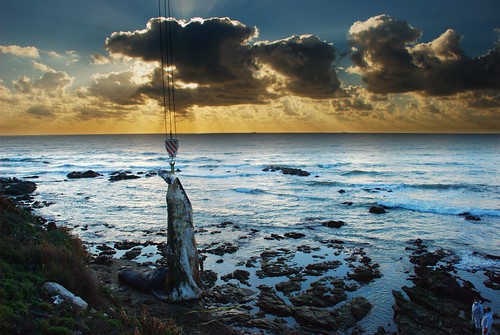A carbon sink with fins
Posted by Big Gav in carbon sequestration, poo, sperm whales
Giles Parkinson has an article in The Business Spectator on an unusual way of sequestering carbon safely in the oceans - A carbon sink with fins.
Australian scientists have found another very good reason to protect the sperm whale, but please finish your breakfast or lunch before reading on.
Research led by Trish Lavery at the School of Biological Sciences at Adelaide’s Flinders University, suggests the poo of the sperm whale is particularly in rich in iron, and because it comes in liquid form and is excreted near the surface, it doesn’t sink rapidly to the ocean floor.
Instead, it inspires the growth of phytoplankton which in turn absorbs carbon dioxide from the atmosphere. It means that even after taking into account the considerable amount of carbon dioxide emitted when these giants of the sea respire, sperm whales are a highly effective, and highly mobile, carbon sink.
And more so than other whales, because as a deep diving feeder, the nutrients it defecates are additional to the total count – other sea animals tend to feed at the surface and simply recycle said nutrients.
Each sperm whale is estimated to absorb at least 35 tonnes of CO2 from the atmosphere each year. From the estimated population of 12,000 Southern Ocean sperm whales that remain after decades of hunting, that amounts to around 400,000 tonnes of CO2 per year.
According to the research, this carbon saved from the current numbers of Southern Ocean sperm whales amounts to just 0.05 per cent of the carbon emitted globally each year by fossil fuel burning, but the numbers of Southern Ocean sperm whales were once ten-fold the current population, and the paper estimates that two million tonnes of CO2 have been left in the atmosphere each year as a result of decimating the sperm whale population.
“This is a previously overlooked impact of industrial whaling,” the report says. Southern Ocean sperm whales, it notes, account for just 3 per cent of the world’s population of sperm whales, which means that the global sperm whale population may be a significant contributor to carbon drawdown. Whales had once been considered to be a net carbon emitter because of their respiration.
The latest paper suggests that other mammals and organisms that consume prey at depth and defecate nutrient rich waste near the surface could be performing a similar function – these include, pygmy whales, baleen whales and fin whales, and possibly also seals and sea-lions, though more research needs to be conducted to ascertain the liquidity and the buoyancy of their poo. A previous Australian-led study suggested that baleen whale faeces once accounted for more than 12 per cent of the iron in the Southern Ocean.
And the point of all this? Well, as nations meet and continue negotiations on how to remove the other 99.95 per cent of fossil fuel emissions under the UN-sponsored climate change talks, such biological solutions will become crucial, and become the basis for new market mechanisms and ascribe a value to hitherto unrecognised assets that will turn the business models of many industries on their head. And companies and their investors need to be aware of this.
It will happen in forestry, for that is what the REDD mechanism that is nearing agreement is designed to do – make the trees that stand in the world’s remaining rainforests more valuable alive than dead. It will likely occur in land use and farming, because these will form a fundamental part of the abatement proposals of the likes of Australia and some other industrialised nations.






